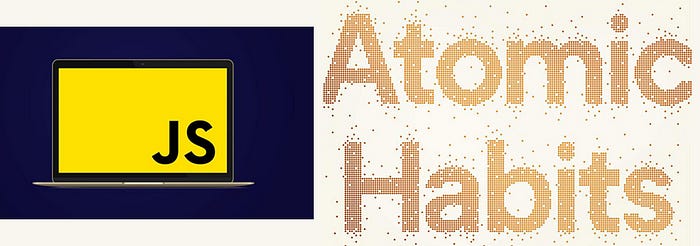“Atomic Habits” and Learning to Code: Habit Stacking, Environmental Design, Worse Over Time
I have taken a break from writing these articles for the last couple of weeks as I have been super busy. Thank you very much for bearing with me!
This is the fourth piece on the ideas put forward in James Clear’s “Atomic Habits” and how they can be utilised in improving coding skills and knowledge.
“Atomic Habits” provides practical insight and strategies for building effective habits and breaking unproductive ones. It is emphasised that small, incremental changes, or “atomic habits,” can lead to significant improvements over time.
There is a more in depth analysis of the book in my first “Atomic Habits” post so it may be worth checking that out before proceeding, although it is certainly not imperative for getting something out of this post. I have also written abouts the topics of identity and beliefs and setting goals put forward in Atomic Habits when establishing improvement in our coding journeys.
This post will outline the concepts of “Habit Stacking”, “Environmental Design” and “Worse Over Time” and their application to progressing in programming.
Habit Stacking
Habit stacking is a behavioral technique that involves associating a new habit you want to develop with a specific trigger or activity you already do regularly. The idea is to use existing, ingrained habits as cues to prompt the performance of new habits. By anchoring the desired behavior to an established routine, you enhance the likelihood of integrating the new habit seamlessly into your daily life.
In the context of learning to code, habit stacking can be a powerful strategy. For instance, you can pair coding practice with an existing daily routine, such as habitually drinking your morning coffee. Each morning, after you pour your coffee, you could dedicate the first 15 minutes to coding exercises or reviewing code. This way, the act of pouring coffee serves as a cue to start your coding session, making it a consistent part of your morning routine. Over time, this habit stacking technique helps reinforce the habit of coding daily, transforming it into a natural and automatic part of your day.
Enviromental Design
Environmental design, in the context of habit formation, involves structuring and arranging your physical surroundings to support and encourage the development of desired habits. It’s about optimizing your environment to make the desired behavior as effortless as possible and reducing any barriers or distractions that might hinder it. By consciously designing your space to align with your goals, you create a conducive atmosphere that nudges you towards positive actions.
In the realm of learning to code, environmental design is especially impactful when you create a dedicated and separate space for coding. Designate a specific area in your home, whether it’s a corner of a room or a separate room altogether, as your coding workspace. Equip this space with a comfortable chair, a well-organized desk, a powerful computer or laptop, and any additional peripherals or tools you need for coding.
This dedicated coding space serves a dual purpose. First, it mentally prepares you for coding by providing a distinct environment associated with the task. When you enter this space, your brain associates it with coding and gears up for focused work. Second, it minimizes distractions associated with other activities, allowing you to fully immerse yourself in the learning process. With a separate coding space, you establish a clear boundary between your learning endeavors and other aspects of your life, facilitating a more effective and immersive coding experience.
Worse Over Time
The concept of “worse over time” in the context of “Atomic Habits” by James Clear emphasizes how small, seemingly insignificant negative actions or habits can accumulate and lead to significant consequences over time. It’s about understanding that the impact of bad habits often goes unnoticed in the short term, but they can have a substantial and detrimental effect on your life and goals in the long run.
Clear argues that habits which may appear harmless or inconsequential can gradually erode your progress and hinder your potential. For example, a habit of skipping a single workout, procrastinating on a small task, or consuming unhealthy snacks occasionally might not seem alarming initially. However, when these actions become recurring habits and start compounding, they can result in a decline in health, productivity, or overall well-being.
In the context of learning to code, this principle emphasizes the importance of identifying and eliminating detrimental habits early in your coding journey. A seemingly minor habit like consistently procrastinating on coding practice or frequently getting distracted can accumulate, hindering your progress and understanding of programming concepts. On the other hand, committing to a daily coding session, no matter how brief, can accumulate into a substantial skill set and solid understanding of coding over time. Being mindful of the ‘worse over time’ principle allows aspiring coders to focus on cultivating positive coding habits, even in their early stages, to ensure a strong foundation and continuous improvement in their programming abilities.
As always, thank you very much for reading! Hit me up with any thoughts or feedback! Next week I’ll be back with more productivity, coding and learning ideas from a very insightful source to help you find ways to get closer to your ambitions!







